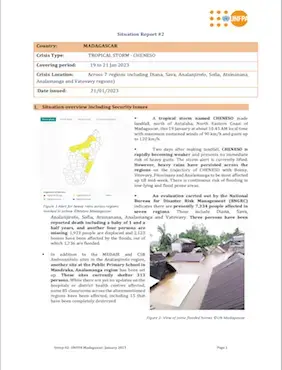Situation overview including Security Issues
A tropical storm named CHENESO made landfall, north of Antalaha, North Eastern Coast of Madagascar, this 19 January at about 10:45 AM local time with maximum sustained winds of 90 km/h and gusts up to 120 km/h.
▪ Two days after making landfall, CHENESO is rapidly becoming weaker and presents no immediate risk of heavy gusts. The storm alert is currently lifted. However, heavy rains have persisted across the regions on the trajectory of CHENESO with Boeny, Vitovavy, Fitovinany and Analamanga to be most affected up till mid-week. There is continuous risk of flooding in low-lying and flood prone areas.
▪ An evaluation carried out by the National Bureau for Disaster Risk Management (BNGRC) indicates there are presently 7,334 people affected in seven regions. These include Diana, Sava, Analanjirofo, Sofia, Atsinanana, Analamanga and Vatovavy. Three persons have been reported death including a baby of 1 and a half years, and another four persons are missing. 1,923 people are displaced and 2,123 homes have been affected by the floods, out of which 1,736 are flooded.
▪ In addition to the MEDAIR and CSB Ambinanitelo sites in the Analanjirofo region, another site at the Public Primary School in Mandraka, Analamanga region has been set up. These sites currently shelter 313 persons. While there are yet no updates on the hospitals or district health centres affected, some 85 classrooms across the aforementioned regions have been affected, including 15 that have been completely destroyed.
Humanitarian needs
▪ The three most affected regions notably Sava, Diana and Analanjirofo have a total population of 3,446,884 including 442,925 adolescent girls. So far, UNFPA targets 1,528,865 people likely to be further plunged into a vulnerable situation by the persistent rains.
▪ Women and girls are most exposed, suffering disproportionately from the passage of the storm that has destroyed fragile shelters and amenities, exposing them to GBV risks and likely to cut them off from access to basic SRH services and commodities. In the three affected regions the following target population has been identified.


